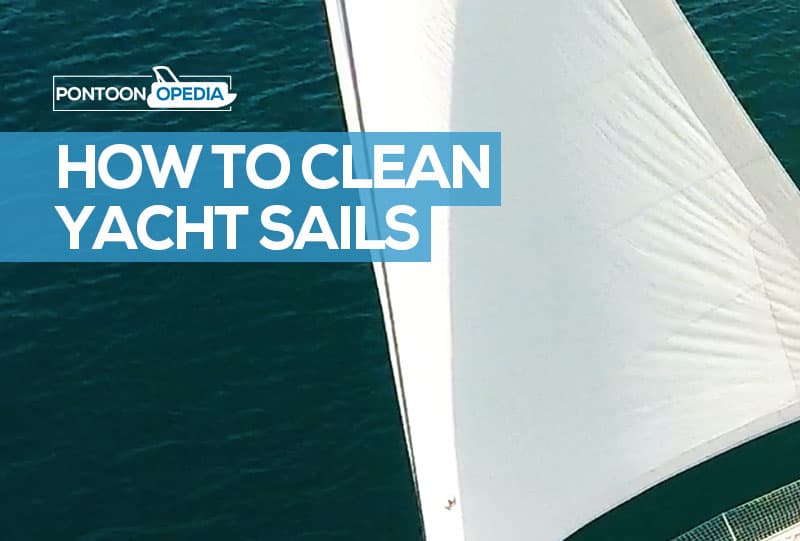Inevitably, your yacht sails will become tarnished from dirt, dust, mildew, mold and sea salt. You may occasionally also get oil, grease, and paint stains on your sails inadvertently while you are doing work on your yacht. They can get very messy, so knowing how to clean yacht sails properly is a key component of responsible ownership.
In this guide, I will explain to you how to keep your sails ship-shape, plus the tricky little tasks on knowing how clean mildew off your yacht sails without damaging them.
How do I clean my yacht sails? Yacht sails, especially those made of nylon, are susceptible to damage from harsh cleaners. Whatever cleaning agent you decide to use, make sure that it is one that will not damage sailcloth fabric. One example of a suitable cleaning agent for your yacht sail is a mild detergent.
In this guide, you will find a collection of helpful tips for cleaning your yacht sails in a variety of circumstances, including the spilling of paint. I have also included guidance on how to keep the water-repellent surface of the fabric intact.
But before you start…
Find out what your yacht sails are made from
Cleaning your yacht sails the right way begins with an understanding of the types of materials that yacht sails are made out of. The ideal cleaning method can vary depending upon which type of fabric the sails are made out of.
Sails are commonly made out of polyester. Polyester is popular thanks to its durability and affordability. Woven polyester sailcloth is a more advanced type of sailcloth that doesn’t require resins to be added to the cloth. An example of woven polyester sailcloth is the FWP series produced by Bainbridge.
Nylon sails are often used for spinnakers because they are lightweight and come at a low cost. They are also quite stretchy, which makes them well-suited for sailing downwind. You will need to be extra careful when you are washing and cleaning nylon yacht sails. Nylon is a material that is susceptible to damage from chlorine.
Important Tip: Avoid using bleach at all costs when cleaning nylon yacht sails as it will damage them.
Table of Contents
How often you should wash your yacht sails
In order to maintain structural integrity and aesthetics, experts recommend that you clean your yacht sails at least twice a year. Routine wash-downs consist of simply applying a mild detergent and warm water solution and finishing the process with a freshwater rinse, as will be discussed in further detail below.
Your sailcloth may occasionally become stained with mildew, mold, rust, or oil-based paints and products. In this case, you will need to enlist the help of a cleaning agent that is a little stronger.
Be sure not to pick a cleaning agent that will ultimately do more harm than good. Below you find safe cleaning agents for a variety of circumstances in which your yacht sail needs to be cleaned.
Avoid harsh cleaning agents or techniques
Sails are made out of materials that are susceptible to damage from harsh cleaning practices. Washing machines must be avoided during the cleaning of yacht sails. Recommendations may vary by sail manufacturer, but most will say that you should only be using fresh water to rinse sails.
If water is not doing the trick, you are encouraged to use one of the mild detergents that will be mentioned below. Detergents should be applied gently with a soft brush.
And here’s how you do it…
How to clean your yacht sails
1. Find a clean and smooth surface
Once you have removed your sails for cleaning, bring them to a clean and smooth surface so that they will not be subject to damage from being scratched against a rough surface. This ensures that the sail remains protected from scratches and during the cleaning process.
If you cannot locate a clean concrete surface, you can also look for a clean section of the lawn. You may consider placing the sail overtop some kind of a plastic sheeting roll, such as this one on Amazon. This will provide added insurance against scratches from a rough surface.
2. Apply soap and spot clean with a soft bristle brush
Apply a mild soapy solution to the surface of the sail and then scrub away gently at persistent spots using a soft-bristled brush like this one on Amazon.
Important Tip: Always just test clean a small area of your yacht’s sails first!
One mild detergent solution you can use to wash the sailcloth includes Woolite Liquid Laundry Detergent on Amazon. A solution with this detergent can be used to wash polyester types of sailcloth fabrics, not those made of nylon. As far as scrubbing motion is concerned, you should be scrubbing in line with the seams of the sail.
After you have gently applied the mild detergent solution with the soft-bristled wash, be sure to rinse the detergent off of the sail fabric. Use warm, freshwater to rinse off the detergent.
Do not fold or stow away the sail without giving it ample opportunity to air dry. Storing sails while they are still wet can cause the fabric to accumulate unsightly mildew.
Important Tip: To avoid the accumulation of mildew on sail fabric, let the sail air dry. You are encouraged to hang the sail on a clothesline to dry.
Additional yacht sail cleaning tips
1. Avoid using solvents on nylon yacht sails
Avoid using solvents to wash yacht sails made out of nylon. Sails made out nylon are particularly vulnerable to damage from harsh cleaning chemicals. Rinse nylon sails with fresh water to clean them.
Then when it comes time to dry out the nylon sail, make sure that you are air drying the nylon fabric. Attempting to use a dryer to dry nylon sails will contribute to damage, as these materials can be susceptible to heat.
2. How to remove mildew from yacht sails
If your sail has accumulated mildew, you can use a highly-diluted sodium hypochlorite solution to wash the fabric. Sodium Hypochlorite is the active ingredient in bleach. Bleach should generally be avoided when cleaning sailing fabrics. However, you can use 3-5% Sodium Hypochlorite to clean mildew off of sails.
You can find Sodium Hypochlorite solutions that are composed of 5% Sodium Hypochlorite by volume (view on Amazon). Further, dilute the solution as necessary to have a Sodium Hypochlorite solution that is less likely to damage the sail fabric in the long run.
Part of the reason that bleach is dangerous for sails is that bleach water emotes the coating from the sail that protects the sail fabric from UV damage. Nylon fabrics are particularly susceptible to damage from UV radiation.
3. Mildew stain remover for marine purposes
You will also find a multitude of mildew stain remover solution for many marine applications such as cleaning boat seats, boat covers, and sails. One of the most popular mildew stain removers is Better Boat Mildew Remover on Amazon. It’s a fantastic yacht sails cleaning product!
The solution comes in a spray bottle and is to be applied liberally to affected sections. You will need to allow several minutes for the solution to settle into the stains, as is recommended by the manufacturer. Otherwise, the product may not be as effective as you would like. Once you are finished, rinse with fresh, clean water.
This product does contain sodium hypochlorite and sodium hydroxide. For this reason, it should only be used as a last resort for cleaning off the nylon fabric sails. This is because the nylon fabric sails can be sensitive to these chemicals.
4. Remove dirt and grease with a specialized canvas cleaner
You can remove dirt and grease by using a specialized canvas cleaner. The Star Brite Sail & Canvas Cleaner- Concentrated Formula on Amazon is one of the more productive solutions for removing dirt and grease from the sail. The ingredients in the concentrated formula include a variety of alcohols and a variety of other chemicals in lower quantities, including citrus extract.
You will need to dilute the solution before applying the cleaner directly onto the sailcloth. Applying the concentrated formula without diluting it first can cause some damage to the fabric.
Below are instructions for using the Star Brite Sail & Canvas Cleaner, as recommended by the manufacturer.
Instructions for using the sail and canvas cleaner:
- Mix 1 part sail & canvas cleaner with 4 parts water
- Wet the surface to be treated with fresh water prior to applying the cleaner
- Apply the cleaner with either a sponge or brush
- Do not allow the solution to dry onto the canvas before reaching it with the sponge or brush
5. Use oxalic acid to remove rust stains
Oftentimes yacht sails can accumulate a bit of rust on their fabrics. The preferred solution for removing rust is a 5% solution of oxalic acid dissolved in water. You can find a concentrated bottle of oxalic acid here. Whatever you do, make sure that you are diluting the oxalic acid and not applying oxalic acid directly onto the sailcloth.
After you have applied the 5% oxalic acid to the sailcloth, you are encouraged to apply a 2% solution of hydrochloric acid to the sail. The link to the solution that I provided is already quite diluted and will require little effort to get down to 2% by volume. Once you have finished applying the hydrochloric acid, rinse the sail with fresh water.
6.Use acetone to remove paint or varnish
Paint and varnish are easier to remove from the sail than you may think. You can use acetone to remove paint from sails, as long as the sail is made out of a more durable fabric such as polyester. Nylon fabric sails can become damaged if you apply acetone to the surface.
Acetone is common in nail polish removers. If you have a nail polish remover lying around the house, you may be able to use the solution to clean paint from your yacht sails. Otherwise, you may consider buying either a nail polish remover like this one online or buying a solution acetone formulating for general cleaning purposes.
Start out by applying the acetone in limited quantities. These chemicals can be quite strong and may take away more than just paint. You are encouraged to brush the chemical in using a soft bristle brush. If the solution is not removing the paint, proceed carefully before applying larger quantities of acetone.
6. Vinegar is the universal stain solvent
Cleaning yacht sails does require you to be conscientious of the damaging effects of chlorine-based cleaners. In some cases, a vinegar solution may be all you need to get your sails looking sharp again. Vinegar is a household product and is not as harmful as many industrial cleaning solvents.
Repeated cleanings with vinegar have been known to be an effective method for controlling mildew on things like boat seats. Soak the affected areas with a solution of vinegar and then rinse off with warm, freshwater. You will likely be able to find a supply of vinegar around the house.
Many sailors say that a mixture of vinegar and a mild detergent is quite an effective solution for general cleaning purposes. One of the most popular detergents for cleaning sailcloth is Woolite Laundry Detergent. Mix the equivalent 2 tablespoons of a mild detergent with 1-2 cups of vinegar 1 gallon of water.
Hand cleaning the sails is generally the best way to avoid damaging the sail fabric.
However, the detergent and vinegar mix is weak enough to be used as a soaking agent. Whatever you do, make sure that you are providing the sails with the opportunity to fully air dry after you have finished the cleaning process.
7. Clean oil-based stains with baking soda
Baking soda is an excellent cleaning solution for oil-based stains such as motor oil, gasoline, and oil-based paints. Baking soda effectively mops up excess oil or grease on the surface. You do not have to worry about baking soda damaging the fabric of the sail.
Start out by applying a generous amount of baking soda to the affected surface area. Allow the applied baking soda the opportunity to soak up excess grease and oil for at least 45 minutes. Simply brush off the baking soda at the end of the waiting period and then apply a mild detergent and warm water solution.
Allow the detergent at least 5-10 minutes to do its magic.
Finish off by rinsing the site with fresh water. You should be able to remove most light oil and grease stains using this method. If this method doesn’t work, it may be time to bring out the big guns.
A degreaser such as DITEC Marine Non-Toxic Degreaser can be used in conjunction with a mild detergent to remove oil and grease stains safely from sail fabrics without damaging the fabric itself. We recommend this degreaser because it does not contain phosphates, ammonia, and VOCs that can be harmful to the marine environment.
Still, you will want to apply it relatively sparingly to the affected area. Per manufacturer recommendations, allow at least 30 seconds for the solution to settle into the fabric before rinsing away.
Rinse first with a mild detergent and warm water before finishing with fresh water to complete the rinse. If mild detergent does not work, this degreaser should be able to do the trick.
8. You will need to restore water repellency
While it is important to clean your yacht sails as part of routine upkeep, an unfortunate consequence of washing sailcloth is that it will lose its water repellency. At least once a year after cleaning, you will need to restore the surface finish.
You can restore the surface finish of your sails by applying a fabric guard such as 303 Marine & Recreation Fabric Guard on Amazon. First, let the fabric dry completely before you apply the fabric guard. You should apply 2 coatings as directed below.
Here is how to apply the fabric guard to your yacht sails, according to the manufacturer’s instructions:
- Only apply on a warm, sunny day (at least 50 degrees Fahrenheit)
- Wait for the sail to dry completely after a thorough cleaning with mild detergent and water, or other cleaning agents as necessary.
- Take the sail to a well-ventilated area where you will not accidentally spray wood finishes, metal pieces or plastic parts of the boat.
- Avoid saturating the fabric; you should use a spray bottle.
- Apply the fabric guard in 2 light coatings rather than 1 heavy coating that will be harder to apply effectively.
- Hold the spray nozzle tip 8 to 12 inches away from the fabric and take care to spray evenly.
- Allow the solvent the opportunity to evaporate between applications.
- Allow 8 to 12 hours for the second coating to dry and cure.
You won’t necessarily need to apply the water repellent coating after each cleaning of the sailcloth, but you should be aware of the effect that repeated cleanings have on the surface finish of the sailcloth.
If you are cleaning your sails more than 2 or 3 times per year, then you may have to apply the fabric guard multiple times a year.
The last word…
If you enjoyed this guide teaching you how to clean your yacht sails and now want your next maintenance projects, then these guides could help!












